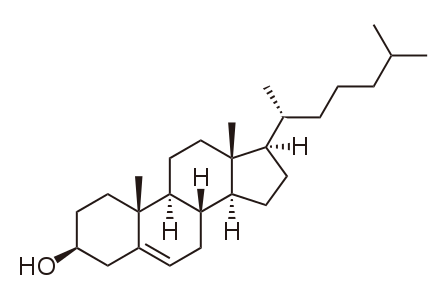Hypercholesterolaemia
Hypercholesterolaemia, commonly known as high cholesterol, refers to the presence of elevated cholesterol levels in the blood. It is a type of hyperlipidaemia (high levels of lipids in the blood) and hyperlipoproteinaemia (high levels of lipoproteins in the blood), which could lead to serious cardiovascular complications.
Signs and Symptoms
Hypercholesterolaemia itself is asymptomatic but can lead to atherosclerosis, characterised by the build-up of fatty plaques in the arteries. Over time, this condition can cause arteries to narrow, impairing blood flow and potentially leading to heart attacks or strokes.

Specific physical findings may include xanthelasma palpebrarum (yellowish patches around the eyelids), arcus senilis (white or grey discolouration of the peripheral cornea), and xanthomata (cholesterol deposits in tendons).

Causes
Diet
Diet plays a significant role in cholesterol levels. High intake of sugar, saturated fats, and trans fats can increase LDL and total cholesterol. Conversely, replacing saturated fats with polyunsaturated fats can help reduce these levels.
Medical Conditions and Treatments
Several medical conditions can elevate cholesterol levels, including type 2 diabetes, obesity, hypothyroidism, and Cushing's syndrome. Medications like thiazide diuretics, glucocorticoids, and beta blockers may also interfere with lipid metabolism.
Genetics
Genetics can contribute significantly, particularly in familial hypercholesterolaemia, which may involve mutations in genes such as APOB, LDLRAP1, PCSK9, or the LDL receptor gene.

Diagnosis
Cholesterol is measured in millimoles per litre (mmol/L) in the UK. For healthy adults, the NHS recommends total cholesterol levels below 5 mmol/L and LDL levels below 3 mmol/L. For high-risk individuals, the thresholds are lower.
Cholesterol Level Interpretation
- Total Cholesterol: <5.2 mmol/L (desirable), 5.2–6.2 mmol/L (borderline), >6.2 mmol/L (high)
- LDL Cholesterol: <2.6 mmol/L (most desirable), 2.6–3.3 mmol/L (good), 3.4–4.1 mmol/L (borderline high), >4.9 mmol/L (very high)
- HDL Cholesterol: <1.0 mmol/L (undesirable), 1.0–1.5 mmol/L (okay), >1.55 mmol/L (good)
Screening
The U.S. Preventive Services Task Force recommends routine screening for lipid disorders starting at age 35 for men and 45 for women, with earlier screening if other risk factors are present. In the UK, family members of individuals with familial hypercholesterolaemia are also advised to undergo screening.
Treatment
Lifestyle and Diet
Lifestyle changes are very important, including smoking cessation, limiting alcohol consumption, increasing physical activity, and maintaining a healthy weight. Dietary recommendations include reducing intake of saturated and trans fats while increasing soluble fibre, fruits, and vegetables.
Medication
Statins are the primary medication used, reducing total cholesterol by about 50%. Other medications include fibrates, nicotinic acid, and cholestyramine, typically used if statins are not tolerated. Injectable antibodies against PCSK9 can also reduce LDL cholesterol.
Guidelines
In the UK, the National Institute for Health and Clinical Excellence (NICE) provides guidelines for managing high cholesterol. These guidelines emphasise the combination of lifestyle modifications and medication for managing elevated cholesterol levels.
Specific Populations
For older adults or those with limited life expectancy, the routine use of lipid-lowering medications may not be beneficial. The American College of Physicians recommends statins for individuals with type 2 diabetes and additional cardiovascular risk factors.
Alternative Medicine
While some herbal and alternative treatments have been looked at, their efficacy remains inconclusive. Phytosterols and phytostanols have been shown to lower LDL cholesterol, but long-term safety data is lacking.
Epidemiology
Rates of high cholesterol have decreased in the United States, with 13% of adults affected as of 2010. Average cholesterol levels vary globally, with lower rates observed in rural China and Japan compared to the UK.
Research Directions
Gene therapy is being looked at as a potential treatment for hypercholesterolaemia.
Self-assessment MCQs (single best answer)
Sure! Below is the formatted output with HTML and pseudocode for the given multiple-choice questions:
What is hypercholesterolaemia commonly known as?
Which of the following is NOT a physical finding associated with hypercholesterolaemia?
Which gene mutation is NOT commonly associated with familial hypercholesterolaemia?
According to the NHS, what is the recommended total cholesterol level for healthy adults?
Which medication class is primarily used to reduce cholesterol levels?
Which dietary component should be increased to help manage high cholesterol?
What is the main complication of untreated hypercholesterolaemia?
At what age does the U.S. Preventive Services Task Force recommend starting routine screening for lipid disorders in men?
Which of the following is a newer treatment option that involves injectable antibodies for reducing LDL cholesterol?
Which of the following dietary changes is recommended for managing high cholesterol levels?
Dentaljuce
Dentaljuce provides Enhanced Continuing Professional Development (CPD) with GDC-approved Certificates for dental professionals worldwide.
Founded in 2009 by the award-winning Masters team from the School of Dentistry at the University of Birmingham, Dentaljuce has established itself as the leading platform for online CPD.
With over 100 high-quality online courses available for a single annual membership fee, Dentaljuce offers comprehensive e-learning designed for busy dental professionals.
The courses cover a complete range of topics, from clinical skills to patient communication, and are suitable for dentists, nurses, hygienists, therapists, students, and practice managers.
Dentaljuce features Dr. Aiden, a dentally trained AI-powered personal tutor available 24/7 to assist with queries and provide guidance through complex topics, enhancing the learning experience.
Check out our range of courses, or sign up now!


